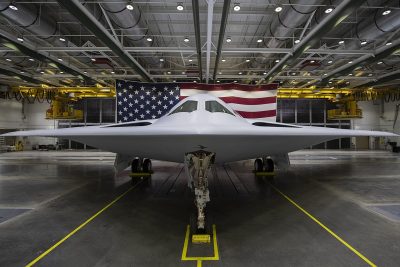The Pentagon Reveals New Stealth Bomber in War Prep Against China
The material in the coating wrapped around the B-21 makes it much harder for adversaries to locate it.

All Global Research articles can be read in 51 languages by activating the Translate Website button below the author’s name.
To receive Global Research’s Daily Newsletter (selected articles), click here.
Follow us on Instagram and Twitter and subscribe to our Telegram Channel. Feel free to repost and share widely Global Research articles.
***
The Pentagon revealed Friday what it believes it can fight China with: the B-21 raider.
Located at an Airforce facility in California, the raider is one of three weapon systems including silo-launched nuclear ballistic missiles and submarine-launched warheads, meant to advance warfare preparations against the “Chinese threat” keeping the US on its toes.
In a statement, the Pentagon said this week of China’s recent military developments that it has birthed “the most consequential and systemic challenge to US national security and the free and open international system.”
Kathy Warden, Chair, CEO, and President of the aerospace and defense technology company Northrop Grumman commented:
“With the B-21 the United States Air Force will deter and defeat threats anywhere in the world,” adding: “The B-21 raider changes everything: reaffirming peace through deterrence, advancing technology, and ushering in a new paradigm in aircraft design, development, and manufacturing.”
Warden also clarified that its operation technique is “extremely advanced compared to the B-2, because the technology has evolved so much in terms of computing capability”, as she stated that the material in the coating wrapped around the B-21 makes it much harder for the adversary to locate it.
As of now, according to Sputnik, six B-21 Raiders are being produced, as the Air Force intends to build around 100 of them that can deploy either nuclear weapons or conventional bombs, which can be manually operated or from a distance.
The Air Force calculated that each B-21 Raider will cost an estimated $692 million to manufacture.
In light of these developments, Chinese Foreign Ministry Spokesperson Zhao Lijian relayed last Wednesday the ways in which the US is devising plans to maintain military hegemony and nuclear power by employing the term “Chinese threat” as a pretext.
The US Defense Department published the 2022 China Military Power Report the day before, claiming that China could catalyze the pace of the modernization of its nuclear forces in the next 10 years, producing around 1,500 nuclear warheads by the year 2035.
During a press briefing, Zhao stated,
“The United States has repeatedly inflated various versions of the Chinese threat theory in recent years to find an excuse to expand its own nuclear arsenal and maintain military hegemony, which is a common US reception,” adding that his country’s nuclear policy is transparent and consistent to the international community.
*
Note to readers: Please click the share buttons above. Follow us on Instagram and Twitter and subscribe to our Telegram Channel. Feel free to repost and share widely Global Research articles.
Featured image: Northrop Grumman B-21 Raider in a hangar at Plant 42, Palmdale, California. (Licensed under the Public Domain)

